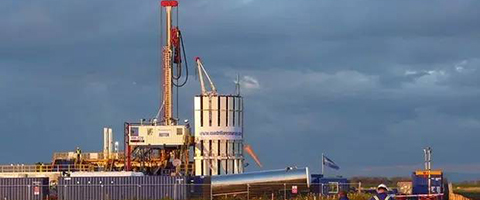

China has one of the largest shale gas reserves in the world, possessing up to 36 trillion cubic meters’ of exploratory reserves.
In March 2012, the Chinese government issued the “Shale Gas Development Plan (2012-2015)”, aiming for an output of 6.5 billion cubic meters by 2015, and 60-100 billion cubic meters by 2020. The Chinese government is placing great importance on shale gas and considers it as a bridge fuel to restructure the domestic energy mix and reduce the share of coal. The government believes that it is feasible to vigorously develop shale gas by copying the so-called successful lessons from the American shale gas boom since 2007. However, achieving this strategy will still face the following two significant challenges.
2020: Shale gas development in China is still in its infancy
According to BP’s Statistical Review of World Energy 2015, China’s consumption of primary energy was 2,970 Mtoe in 2014, with coal accounting for 66%, oil 17.5% and natural gas 5.6%. Coal still overwhelmingly dominates China’s energy system, resulting in air pollution and high carbon emissions. To solve these problems, China has begun to increase the consumption and importation of massive amounts of natural gas since 2011. According to the government’s “Energy Development Strategy Action Plan 2014-2020”, natural gas will account for 10% by 2020 in China’s national primary energy mix, equivalent to over 360 billion cubic meters, a twofold increase from 2014 to 2020. While high natural gas consumption is expected to continue into the future, the output of shale gas in China has not been following this trend. The production in 2014 was only 1.3 billion cubic meters, and there are still doubts whether China will be able to achieve the target of 6.5 billion cubic meters by 2015. The National Energy Administration therefore lowered the quantitative target of shale gas exploitation in 2020, down from 60-100 billion cubic meters to 30 billion cubic meters[1]. From this perspective, even if the output target is achieved by 2020, shale gas will still account for only 8.5% of the target consumption of natural gas for that year.
2030:It is difficult for China to follow America in shale gas development
Over the past decade, the most important external factor to promote China’s independent development of shale gas was the unexpected development of shale gas in the United States. China hopes it can replicate the example of America, but the time window to develop large-scale shale gas in China will be the decade of 2021-2030. By around 2030, when China’s carbon emissions peak, fossil fuels, including natural gas, will be under pressure to cut carbon emissions. In addition, renewable energy, largely wind power and solar energy will be more cost-competitive by this time. Thus the transition period for renewable energy to replace fossil fuels and dominate the energy system will be between 2030-2050. The post-2030 international and domestic climate policy environment will not provide an opportunity to develop large-scale shale gas before 2030.
In order to replace coal, natural gas will retain its high growth rate during 2021-2030. The proportion of natural gas in primary energy consumption will increase from 10% in 2020 to 15% in 2030, approximating 650 billion cubic meters annually by 2030[2]. If the output of shale gas grows rapidly after 2020, we assume that the domestic shale gas production will account for 40-50% of natural gas consumption by 2030, as America has achieved by 2014. Thus China’s annual output of shale gas will be 260-325 billion cubic meters by 2030.
Such huge development can only be achieved with the support of greater government expenditure in subsidies. To reduce the amount of subsidies, the government has lowered the subsidy rate in 2015 for shale gas, from 0.4 RMB per cubic meter in 2012-2015[3], to 0.3 RMB per cubic meter in 2016-2018, and further down to 0.2 RMB per cubic meter in 2019-2020[4]. According to the target in 2020, the direct subsidies for shale gas will be 6 billion RMB (circa 0.94 billion USD), which is equivalent to 9% of added value to renewable energy in 2014. When the gap of renewable energy subsidies increases, it seems that the public funding would be more wisely spent on supporting the development of renewable energy.
Another major challenge is whether the required high scale of investment can keep up with the exploitation of shale gas. The total investment scale is estimated to be around 160 billion USD to reach an annual output of 300 billion cubic meters. Facing such large investment barriers, policymakers should have a careful look at the position of shale gas in the process of the Chinese energy transition. This should include, placing greater consideration on international climate change policy, the environmental and social impact of shale gas development, price fluctuations of international oil and gas markets and overall economic trends.
Reference
[1]“China’s shale gas production rose to 1.3 billion cubic meters in 2014” Link: http://www.cet.com.cn/nypd/trq/1437986.shtml , Last access: 20/11/2015
[2]“Strategy of China’s energy development in the future” Link: http://www.nea.gov.cn/2014-02/12/c_133109179.htm , Last access: 20/11/2015
[3]“Subsidy policy on shale gas development” Link: http://news.xinhuanet.com/fortune/2012-11/06/c_123917386.htm , Last access: 20/11/2015
[4]“Notice of utilization of financial subsidies on shale gas development” Link: http://jjs.mof.gov.cn/zhengwuxinxi/zhengcefagui/201504/t20150427_1223392.html , Last access: 20/11/2015
Author:Zhao Ang and Lin Jiaqiao




